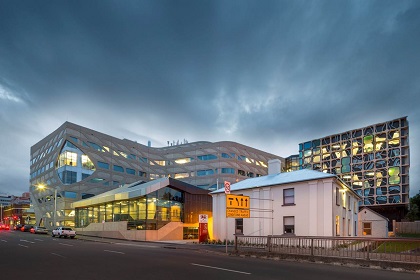UTAS Medical Science Precinct launched

UTAS Medical Science Precinct launched
University of Tasmania Vice-Chancellor Professor Peter Rathjen has officially launched the UTAS Medical Science Precinct.
University of Tasmania Vice-Chancellor Professor Peter Rathjen has officially launched the UTAS Medical Science Precinct.
Professor Rathjen said the Precinct would bring a single identity to a number of world-class institutions and activities.
The Medical Science Precinct encompasses the city's iconic MS1 and MS2 buildings, along with the Domain campus of UTAS, which contains the School of Nursing and Midwifery.
The Precinct is part of UTAS's vision for a new heart for Hobart, linking with the $120 million Melville Street student accommodation, the new IMAS waterfront headquarters and $75 million Academy of Creative Industries and Performance Arts, co-located with the Theatre Royal.
"We have a constellation of truly outstanding research and teaching activities happening within the Medical Science Precinct," Professor Rathjen said.
"These activities are global in both standard and scope.
"It is fitting that these elements should be afforded a single identity which is both immediately powerful and full of promise for the future."
The precinct launch coincides with the 25th anniversary of the establishment of the Menzies Research Institute Tasmania.
Menzies is the home of world-class research that focuses on the major diseases affecting the Tasmanian community, including arthritis, cancer, multiple sclerosis, cardiovascular disease, diabetes type-2, osteoporosis, mental health, obesity and dementia.
UTAS's Faculty of Health Science has a large footprint across the Precinct, including the School of Medicine, and with Paramedic and Nursing teaching at the Domain. It has strong partnerships with health care providers, including the Royal Hobart Hospital, which is collocated with the Precinct.
The Faculty is developing an academic health science culture, also carrying out world class research, including the School of Medicine's Wicking Dementia Research and Education Centre, which was responsible for the University's first MOOC (Massive Open Online Course). Titled Understanding Dementia, it was taken up by 9300 participants world-wide and boasted a startlingly high completion rate compared to global benchmarks.
Menzies director Professor Tom Marwick said: "The Medical Science Precinct doesn't just represent the good work we already do within Menzies and Faculty of Health Science as health and medical research and teaching organisations.
"It captures the potential of what we can do when we bring world-class teachers and
researchers together with talented students, which ultimately will deliver benefit to our communities.
"The Precinct would not have been possible without the support and partnership of the Federal Government, State Government and contributions from philanthropic organisations and private donors who share our vision.
"For the university, this partnership speaks of a sense of purpose, with our research and teaching aimed at creating knowledge and having it apply in ways not thought of before. It also speaks to the enhanced economic opportunities for Tasmania that research, and education, can bring."
Faculty of Health Science Dean Professor Denise Fassett said teaching and research in health and medicine was central not only to university's future, but to Tasmania's more broadly.
"By the aged care industry's own figures, the 7000-strong workforce in Tasmania will need to double or treble heading towards 2050," she said. "UTAS is well placed to produce that workforce for the future."
The University continues to pursue the Northern Health Initiative (NHI), which would deliver an economic return to Tasmania of $1.235 billion to Tasmania over 10 years and train more than 3400 graduates.
"The UTAS Faculty of Health Science and institutes, such as Menzies, inhabit the very cutting edge of health and medical research and teaching," Professor Fassett said.
"The unveiling of this Precinct today is an important step to consolidating these activities and providing the platform to build upon into the future."
The Medical Science Precinct was made possible by funding from the Australian Federal Government through the Health and Hospitals Fund ($44.7m), the Capital Development Pool grant ($12m) and the Better Universities Renewal Fund ($11.5m).
The Tasmanian State Government contributed $24m in funding and in-kind support. Private donors and philanthropic organisations including The Atlantic Philanthropies and The Select Foundation have contributed a total of $21.5m to the project. The University of Tasmania contributed $34m to the project.
Contact:
Phone:
Email: